

23 Great Lesson Plans for Internet Safety. Help kids practice smart internet habits and stay safe online.

Educators' approach to internet safety in the classroom has changed as technology and our use of it continues to evolve. In the past, digital citizenship lessons on internet safety focused more on dos and don'ts, like do create safe passwords and don't talk to strangers online. While secure passwords are certainly important for technology users of all ages, and stranger danger is nothing to take lightly, most internet safety dilemmas are much more nuanced. The best internet safety lessons recognize the complexity of these topics and help students build the critical-thinking skills and habits of mind to navigate the dilemmas they encounter. Below are the best internet safety lesson plans for students in grades K–12. Kindergarten Internet Safety Lesson Plans Safety in My Online Neighborhood How do you go places safely online?
First Grade Internet Safety Lesson Plans Pause & Think Online Internet Traffic Light That's Private! A Real Lesson in Digital Citizenship. My students and I had an “a-ha” moment the other day, in terms of digital citizenship and how we really need to think before we post images to the Internet.

Or maybe even before we take the picture. We are working hard to discourage our students from taking “candids” of each other at school, and more important, from posting those pictures on their favorite social network. I know that may sound strange to many readers, but I teach some very transient, very high-risk kids, and we cannot guarantee the safety of some of our students if other kids are taking their pictures (and then posting them on Facebook to share with friends). It’s a difficult situation. Everybody with a hand-held device has the ability to take a picture (and many can take video). What we’re trying to cut down is the great shot of your “bestie” doing cartwheels on the yard that might also show the faces of three kids in the background who aren’t supposed to have their photos taken.
Teachable moments. Digital Citizenship Consulting - Education, Technology Support. Digital Citizenship: Resource Roundup. Digital Citizenship: Making the Online World a Better Place Starts With You! Your students were born into a digital world.
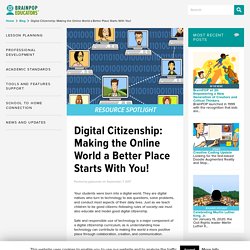
They are digital natives who turn to technology to ask questions, solve problems, and conduct most aspects of their daily lives. Just as we teach children to be good citizens–following rules of society–we must also educate and model good digital citizenship. Safe and responsible use of technology is a major component of a digital citizenship curriculum, as is understanding how technology can contribute to making the world a more positive place through collaboration, creation, and communication.
Digital Citizenship Videos. 3 Ways to Make Digital Citizenship Part of Your Everyday Teaching. Tips for modeling responsible tech use and critical thinking.
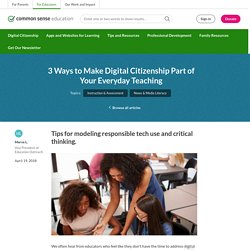
We often hear from educators who feel like they don't have the time to address digital citizenship in their classrooms. With an already overloaded to-do list of annual teaching objectives, setting aside a week (or even a day) to focus on responsible technology use -- let alone making time to plan those extra lessons -- feels challenging. Shouldn't these skills be taught in homeroom? Or by the media specialist during library time? Digital Citizenship Curriculum. Digital Citizenship Curriculum Tutorial.
Google Releases Free Course to Help Educators Teach Digital Literacy & Citizenship. STAYING SAFE IN THE WILD WILD WEB: Google has released a free online training course around digital literacy and citizenship to help teachers instill safe habits in students.
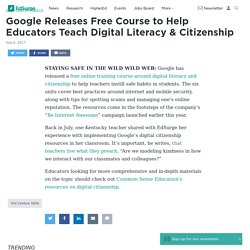
The six units cover best practices around internet and mobile security, along with tips for spotting scams and managing one’s online reputation. The resources come in the footsteps of the company’s “Be Internet Awesome” campaign launched earlier this year. Back in July, one Kentucky teacher shared with EdSurge her experience with implementing Google’s digital citizenship resources in her classroom. It’s important, he writes, that teachers live what they preach. “Are we modeling kindness in how we interact with our classmates and colleagues?” Digital Citizenship. Digital Citizenship. Digital Citizenship Curriculum. What Your Students Really Need to Know About Digital Citizenship. In my classroom, I use two essential approaches in the digital citizenship curriculum that I teach: proactive knowledge and experiential knowledge.
Proactive Knowledge I want my students to know the “9 Key Ps” of digital citizenship. While I go into these Ps in detail in my book Reinventing Writing, here are the basics: 1. Passwords: Do students know how to create a secure password? 2. 3. 16 Digital Citizenship Scenarios Middle Students Will Enjoy. Teaching digital citizenship means encouraging a sense of awareness, responsibility, and accountability in our learners.

The online world is a digital wonder, but it can be a dangerous place. Having skills that allow us to protect ourselves and others online are a necessity for making these spaces safe for everyone. Global Digital Citizen Foundation. 5 Excellent Videos to Teach Your Students about Digital Citizenship.
Definition Of Digital Citizenship. The Definition Of Digital Citizenship by Terry Heick This post was originally published in 2013 and was updated in December of 2018.
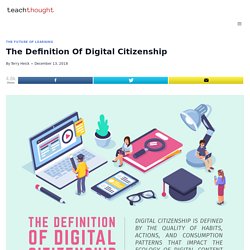
The Basics Of Digital Citizenship: 27 Power Verbs to Guide Children Online - The Basics Of Digital Citizenship: 27 Power Verbs to Guide Children Online by TeachThought Staff How can you promote digital citizenship in students?
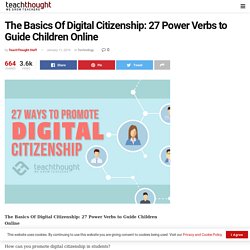
We’ve offered that the definition of digital citizenship can be thought of as, roughly, “The quality of habits, actions, and consumption patterns that impact the ecology of digital content and communities.” In short, citizenship online and offline is very similar. It boils down to treating people and places with the respect and care required to help them thrive. Google lanza nuevos recursos para enseñar ciudadanía digital a los niños. El equipo de Google anunció nuevas actividades para complementar su iniciativa sobre aprendizaje de seguridad y ciudadanía digital para niños.

“Sé genial en internet” es uno de los recursos creados por Google para ayudar a los niños a evaluar el contenido online. 9 critical cyber safety lessons to teach your kids. Infographic: Citizenship in the digital age. The Global Citizen Diploma – The Story Is More Than Numbers. Digital Citizenship. Interland: un juego que enseña lecciones digitales de seguridad. Mashable. The last thing young people want is another set of rules.
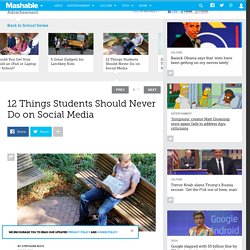
But these days, social media comes with great responsibility, whether you're just starting high school or finishing up college. The fact is, irresponsible social media conduct could potentially ruin your education and negatively impact your career, not to mention hurt others in the process. (And we're not just talking kids, either.) But most of those consequences are preventable, often with just a little foresight. We've pinpointed 12 social media mistakes that students should avoid at all costs, because after all, it's never as simple as "be responsible. " Please head to the comments below to add your own contributions and advice for young adults on social media. 1. Granted, high school and college students experiment with many activities and substances.
Once or twice per year, perform a thorough review of the information and content accessible on your social media profiles. Digital Citizenship Week: 6 Resources for Educators. Considering how ubiquitous smartphones and tablets have become, especially in high school and middle school, questions about managing use and educating students about digital etiquette are on a lot of educators' minds. This October, Common Sense Media is sponsoring Digital Citizenship Week from October 16 to October 22. And we wanted to pull together some of the best resources to help educators talk about digital responsibility and safety online. Here, you'll find resources that cover today's digital landscape, ideas for student activities, and strategies for engaging parents.
There are plenty of valuable resources for educators and parents to share, but here are six of my favorites: Digital Citizenship Resources. 9 Key P's of Digital Citizenship. 8 digital life skills all children need – and a plan for teaching them. A generation ago, IT and digital media were niche skills. Today, they are a core competency necessary to succeed in most careers. That’s why digital skills are an essential part of a comprehensive education framework. Without a national digital education programme, command of and access to technology will be distributed unevenly, exacerbating inequality and hindering socio-economic mobility. What’s your DQ? The challenge for educators is to move beyond thinking of IT as a tool, or “IT-enabled education platforms”. Like IQ or EQ – which we use to measure someone’s general and emotional intelligence – an individual’s facility and command of digital media is a competence that can be measured.
DQ can broadly be broken down into three levels: Digital Footprint: Leaving a Mark. Digital citizenship in education - Recherche Google. Digital Citzenship Resources. Digital Citizenship and Digital Literacy. PantallasAmigas : Por un uso seguro y saludable de Internet, la telefonía móvil y los videojuegos - Por una ciudadanía digital responsable.
¿Eres tan anónimo en la Red como te crees? #NoSeasEstrella. BCPS Digital Citizenship Scope and Sequence. Why Every Classroom Should Teach Digital Citizenship. By Paul Barnwell, Teacher of English & Digital Media Students buzzed about the latest uproar on Instagram. Anonymous sources had posted a ‘questionable’–and NSFW–list for multiple public schools in our city on Instagram, leading to distraught girls, viral Twitter reactions, and an investigation. This type of cyberbullying and reckless use of digital communication is rampant among teens, but this recent episode was only unusually due to its elevated publicity.
Every day, I see a student deficit on how to mindfully employ the unbridled potential and power of their smartphones and other digital tools. But who’s to blame? Is it those cruel sources who exploit the images? Is it parents who purchase smartphones and laptops for their children and fail to set boundaries or teach their kids about responsible use? Is it the lack of education and discussion in schools about the ways students can be more mindful, responsible users of technology? A combination, of course. 1. 2. 3. 4. 5. Digital Citizenship in Schools. Free Resources to Teach Kids The Fundamentals of Digital Citizenship. October 14, 2017 After featuring this free resource to help teachers better integrate the ethos of digital citizenship in their instruction, we are sharing with you this equally important resource designed specifically for kids.
Be Internet Awesome is a resource kit created by Google to teach kids ‘the fundamentals of digital citizenship and safety so they can explore the online world with confidence.’ Be Internet Awesome provides kids with useful tips on different areas related to online safety. They include tips on how to responsibly share digital content and communicate with others, how to discern between what’s real and what’s fake, how to safeguard valuable information and protect personal privacy and many more. Resources for Teaching Digital Citizenship. As we continue to move forward into this age of explosive technology use, educators and families must find ways to teach children how to use their phones, tablets, and computers ethically, responsibly, and wisely. Our anxiety increases with every case of cyberbullying or identify theft reported on the evening news. How do adults, many of whom struggle to keep up with each new tech innovation, teach students the skills they urgently need to use technology for good and not ill?
First, we need to be proactive and educate ourselves. Five Good Resources for Teaching Digital Citizenship to Middle School and High School Students. Digital Citizenship Week: 6 Resources for Educators. Digitial citezshiip. Nine Themes of Digital Citizenship. Common Sense Education. InCtrl - Lesson: Digital Citizenship. Be Internet Awesome - Resources. Digital citizen infographic final. 15 Top Resources On Digital Citizenship for 2014.
A lot of the facts you teach your students will be long forgotten by the time they reach graduation, but the hope is that the practical lessons — the ones that can benefit them for years to come — are the ones that will stick. Be a Digital Citizen. Common Sense Education. Digital Citizenship in the Real World. Digital citizenship starter kit 0. Digital Citizenship Week: 6 Resources for Educators. Fantastic Resources for Teaching Digital Citizenship Education in Your Classroom. About ETR Community EdTechReview (ETR) is a community of and for everyone involved in education technology to connect and collaborate both online and offline to discover, learn, utilize and share about the best ways technology can improve learning, teaching, and leading in the 21st century.
EdTechReview spreads awareness on education technology and its role in 21st century education through best research and practices of using technology in education, and by facilitating events, training, professional development, and consultation in its adoption and implementation. Five Good Resources for Teaching Digital Citizenship to Middle School and High School Students.
How to Take Digital Citizenship Schoolwide During the 2016-17 School Year. Since our students are using technology to play, learn, and communicate while at home and at school, they should be learning how to use that technology responsibly. Full integration of digital citizenship (or DigCit) curriculum into every class and every content area—at every grade level—should be the goal to meet this need. What is Digital Citizenship? Nine Themes of Digital Citizenship. What Your Students Really Need to Know About Digital Citizenship. Digital Citizenship Spotlight. Now that the school year is in full swing, remember to check out the BrainPOP Spotlight on Digital Citizenship. More than ever, classrooms are going digital, and it’s our job as teachers to help students understand appropriate online behavior and the importance of interacting respectfully. 3 Simple Steps to Help Students Become a Global Citizen. Like squirrels in a sack, we can choose to coexist or we can make life miserable for one another.
We are all a global citizen whether we realize it or not. The 6 Online Research Skills Your Students Need. Digital Citizenship Resources for Teachers. Digital citizenship starter kit 0. 8 digital life skills all children need – and a plan for teaching them. Digital citizen infographic final. Digital Citizenship Poster for Elementary Classrooms. Home. Common Sense Digital Citizenship: Certified Educator.
Digital Citizenship Flashcards. Digital Literacy/Digital Citizenship. Teaching Students Good Digital Citizenship. Scope & Sequence: Common Sense K-12 Digital Citizenship Curriculum. Las habilidades digitales que nuestros niños deberían aprender. 18 Incredible Digital Citizenship Web Resources for Teachers. Safer Internet Day: A Teacher's Guide to Teaching Digital Citizenship. Internet safety - internet safety tips. What Is Digital Citizenship? InCtrl. 8 competencias digitales que debemos enseñar a los más jóvenes.
Online Safety and Digital Citizenship. Playing and Staying Safe online. Digital Citizenship. Internet Safety and Digital Citizenship. Internet Safety and Digital Citizenship Presentations for Students, Parents and Teachers. Why are words so important, and how can students practice digital citizenship? Digital Citizenship: Resource Roundup. The 9 elements of digital citizenship. The Web we want: activities about eSafety, with a handbook for teachers and a handbook for students. K-12 Digital Citizenship Curriculum. K-12 Digital Citizenship Curriculum. 8 digital skills we must teach our children. Middle school students learn how to be good ‘digital citizen’
Teaching The Concept Of Digital Footprint To Middle School Students. Google Digital Literacy and Citizenship Curriculum — ikeepsafe.org. Office of the Children's eSafety Commissioner. Teacher's Guide to Digital Citizenship.